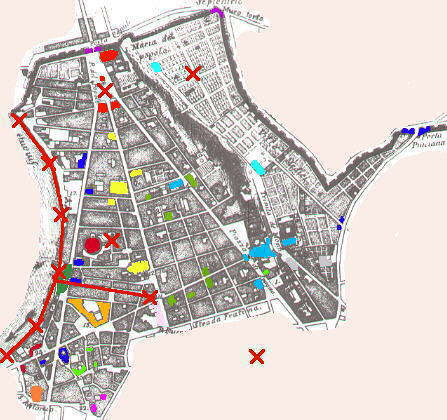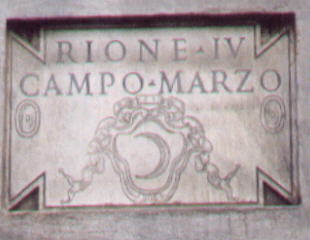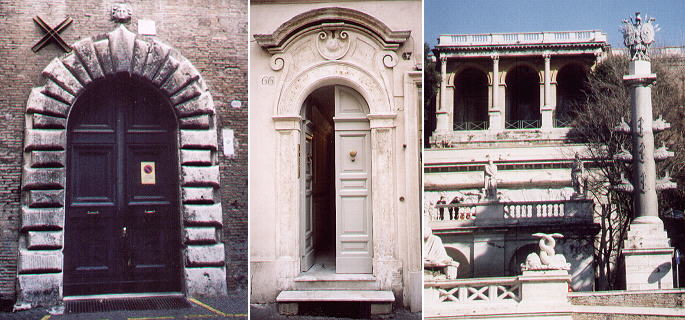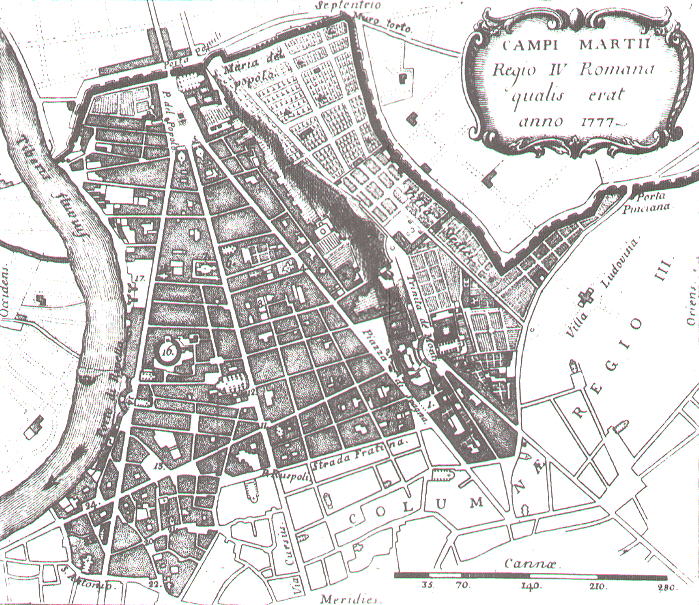  Rione IV Campo Marzio
Rione Campo Marzio retains the name that the Romans gave to the whole area between
the seven hills and the river. It means Field of Mars, the Roman god of war, because the Roman army used the area
to drill the troops. It borders to the west on the river and on Ponte,
to the south on Sant' Eustachio, to the east on Colonna and to the north on the walls of Rome.
The symbol of Rione Campo Marzio is a crescent. The main Roman monument of Campo Marzio is Mausoleo di Augusto, the tomb of the first Roman emperor. The Roman law did not allow tombs and in general burial grounds within the borders of the city, but at the time of Augustus the area was outside the borders. There were other Roman tombs along Via Flaminia in today's Piazza del Popolo: their ruins can still be seen in XVIth century maps. The development of the area is associated with the introduction in 1300 of the Jubilees or Holy Years. These events attracted masses of pilgrims who reached Rome via Ponte Milvio and Via Flaminia and arrived in town through Porta del Popolo. Inns for the pilgrims, the hospital of S. Giacomo degli Incurabili, the church of S. Maria del Popolo were the first buildings of Campo Marzio. In the early XVIth century two Medici popes Leo X and Clemens VII opened the two streets (Via di Ripetta and Via del Babuino) which together with Via del Corso make up the Trident with the three streets departing from the same point, where at the end of the same century Sixtus V located a gigantic obelisk. While these streets had a north-south direction a new street, Via Trinitatis (today Via de' Condotti) provided an east-west connection by linking the area near Porto di Ripetta with TrinitÓ de' Monti.
Neoclassic decoration in Piazza del Popolo Campo Marzio was embellished in the XVIIth century by the addition of S. Carlo al Corso and of the almost twin churches of S. Maria dei Miracoli and S. Maria in Montesanto. In the XVIIIth century Scalinata di TrinitÓ de' Monti (the Spanish Steps) and in the XIXth century the Neoclassic redesigning of Piazza del Popolo and the gardens of il Pincio made Campo Marzio the quarter preferred by the foreigners to the point of being called the Strangers' Quarter.
1) Palazzo Mignanelli 2) Scalinata di TrinitÓ de' Monti 3) Teatro d'Alibert 4) S. Atanasio 5) S. Maria in Montesanto 6) Ges¨ e Maria 7) S. Giacomo degli Incurabili 8) SS. Giuseppe e Orsola 9) Palazzo Nunez 10) Palazzo di Spagna 11) SS. TrinitÓ 12) S. Carlo al Corso 13) Palazzo Borghese 14) S. Girolamo degli Schiavoni 15) S. Rocco 16) Mausoleo di Augusto 17) Porto della Legna 18) S. Maria in Porta Paradisi 19) SS. Biagio e Cecilia 20) Palazzo Firenze 21) S. Nicola de' Perfetti 22) S. Maria in Campo Marzio 23) S. Ivo dei Bretoni 24) Collegio Clementino 
Main monuments of Rione Campo Marzio The red X mark the main changes which occurred after 1777: a) line linking several X: in the 1880s huge walls were erected along the Tiber: this led to the loss of Porto di Ripetta; b) two X in the upper part of the map: in the early XIXth century Piazza del Popolo was redesigned and the nearby hill of Il Pincio became a public garden; c) X near a round building: in 1934 the area around Mausoleo di Augusto was largely modified with the loss of several old streets; d) X at the end of a line: in 1902 a new bridge required the opening of a street leading from it to Via de' Condotti. The different colours group the monuments which are shown in the same page. You can also have a look at it from the Janiculum: Porto di Ripetta and Piazza Navona.
 or to
The Coats of Arms of the Popes or
to My Home Page on Baroque Rome or to
My Home Page on Rome in the footsteps of an XVIIIth century traveller or to
The Coats of Arms of the Popes or
to My Home Page on Baroque Rome or to
My Home Page on Rome in the footsteps of an XVIIIth century traveller
|
All images © 1999 - 2004 by Roberto Piperno. Write to romapip@quipo.it


